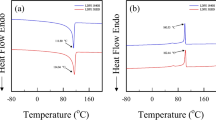Abstract.
A newly developed method for determining the frequency-dependent complex Young's modulus was employed to analyze the mechanical response of compacted microcrystalline cellulose, sorbitol, ethyl cellulose and starch for frequencies up to 20 kHz. A Debye-like relaxation was observed in all the studied pharmaceutical excipient materials and a comparison with corresponding dielectric spectroscopy data was made. The location in frequency of the relaxation peak was shown to correlate to the measured tensile strength of the tablets, and the relaxation was interpreted as the vibrational response of the interparticle hydrogen and van der Waals bindings in the tablets. Further, the measured relaxation strength, holding information about the energy loss involved in the relaxation processes, showed that the weakest material in terms of tensile strength, starch, is the material among the four tested ones that is able to absorb the most energy within its structure when exposed to external perturbations inducing vibrations in the studied frequency range. The results indicate that mechanical relaxation analysis performed over relatively broad frequency ranges should be useful for predicting material properties of importance for the functionality of a material in applications such as, e.g., drug delivery, drug storage and handling, and also for clarifying the origin of hitherto unexplained molecular processes.
Similar content being viewed by others
References
G. Alderborn, in Pharmaceutics The Science of Dosage Form Design, edited by M.E. Aulton, second edition (Churchill Livingstone, New York, 2002) pp. 397-440.
B.C. Hancock, C.R. Dalton, S.D. Clas, Int. J. Pharm. 228, 139 (2001).
S. Malamataris, J.E. Rees, Int. J. Pharm. 92, 123 (1993).
G.W. Radebaugh, S.R. Babu, J.N. Bondi, Int. J. Pharm. 57, 95 (1989).
D.V. Moe, E.G. Rippie, J. Pharm. Sci. 86, 26 (1997).
R.S. Lakes, Rev. Sci. Instrum. 75, 797 (2004).
S. Mousavi, K. Welch, U. Valdek, B. Lundberg, Int. J. Impact Eng. 31, 1133 (2005).
G. Fantozzi, Mechanical Spectroscopy Q-1 2001, Vol. 366-3 (Trans Tech Publications, Inc., Switzerland, 2001) pp. 3-31.
C. Zener, J. Appl. Phys. 18, 1022 (1947).
G.K. Bolhuis, Z.T. Chowhan, in Pharmaceutical Powder Compaction Technology, edited by G. Alderborn, C. Nyström, Vol. 71 (Marcel Dekker, Inc., New York, 1996) pp. 419-500.
P.N. Davies, J.M. Newton, in Pharmaceutical Powder Compaction Technology, edited by G. Alderborn, C. Nyström, Vol. 71 (Marcel Dekker, Inc., New York, 1996) pp. 165-191.
M.M. Al-Mousawi, S.R. Reid, W.F. Deans, Proc. Inst. Mech. Eng., Part C: J. Mech. Eng. Sci. 211, 273 (1997).
J. San Juan, Mechanical Spectroscopy Q-1 2001, Vol. 366-3 (Trans Tech Publications, Inc., Switzerland, 2001) pp. 32-73.
S. Etienne, S. Elkoun, L. David, L.B. Magalas, Mechanical Spectroscopy Ii, Vol. 89 (Trans Tech Publications, Inc., Switzerland, 2003) pp. 31-66.
S. Havriliak, S. Negami, Polymer 8, 161 (1967).
A.K. Jonscher, Dielectric Relaxation in Solids (Chelsea Dielectrics Press, 1983).
S. Havriliak jr., S.J. Havriliak, Dielectric and Mechanical Relaxation in Materials (Hanser Publishers, Munich, 1997).
R.M. Hill, A.K. Jonscher, Contemp. Phys. 24, 75 (1983).
R.M. Hill, J. Mater. Sci. 17, 3630 (1982).
J. Einfeldt, D. Meissner, A. Kwasniewski, Cellulose 11, 137 (2004).
J. Einfeldt, D. Meissner, A. Kwasniewski, Progr. Polym. Sci. 26, 1419 (2001).
M. Naoki, S. Katahira, J. Phys. Chem. 95, 431 (1991).
A. Faivre, G. Niquet, M. Maglione, J. Fornazero, J.F. Jal, L. David, Eur. Phys. J. B 10, 277 (1999).
R. Nozaki, D. Suzuki, S. Ozawa, Y. Shiozaki, J. Non-Cryst. Solids 235, 393 (1998).
E. Shotton, D. Ganderton, J. Pharm. Pharmacol. 13 (Suppl.), 144 (1961).
H. Olsson, S. Mattsson, C. Nyström, Int. J. Pharm. 171, 31 (1998).
S. Mattsson, C. Nyström, Eur. J. Pharm. Sci. 10, 53 (2000).
H. Rumpf, in Agglomeration, edited by W.A. Knepper (Interscience Publishers, New York, 1962) pp. 379-418.
C. Nyström, P.G. Karehill, in Pharmaceutical Powder Compaction Technology, edited by G. Alderborn, C. Nyström, Vol. 71 (Marcel Dekker, Inc., New York, 1996) pp. 17-53.
H. Olsson, C. Nyström, Pharm. Res. 18, 203 (2001).
Y.S. Lee, R. Poynter, F. Podczeck, J.M. Newton, AAPS PharmSciTech 1, E21 (2000).
T.M. Tsai, J.S. Wu, H.O. Ho, M.T. Sheu, J. Pharm. Sci. 87, 117 (1998).
J.D. Ferry, Viscoelastic Properties of Polymers, third edition (Johy Wiley & Sons, Inc., New York, 1980).
M. Strømme, A. Mihranyan, R. Ek, G.A. Niklasson, J. Phys. Chem. B 107, 14378 (2003).
Author information
Authors and Affiliations
Rights and permissions
About this article
Cite this article
Welch, K., Mousavi, S., Lundberg, B. et al. Viscoelastic characterization of compacted pharmaceutical excipient materials by analysis of frequency-dependent mechanical relaxation processes. Eur. Phys. J. E 18, 105–112 (2005). https://doi.org/10.1140/epje/i2005-10032-8
Received:
Accepted:
Published:
Issue Date:
DOI: https://doi.org/10.1140/epje/i2005-10032-8




